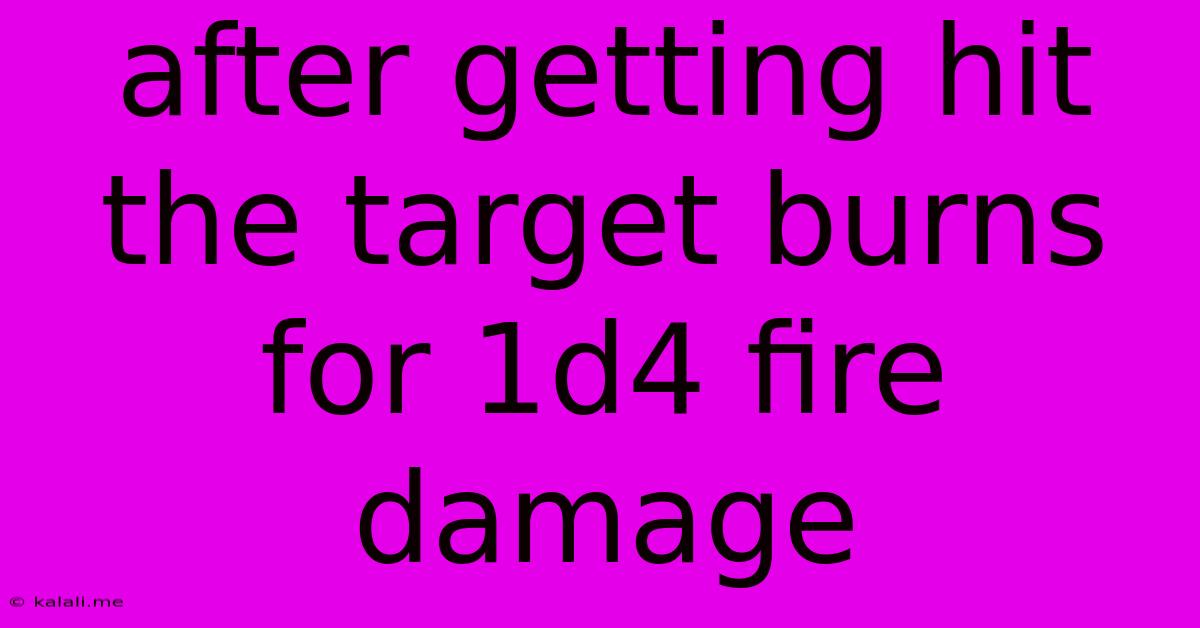After Getting Hit The Target Burns For 1d4 Fire Damage
Kalali
May 24, 2025 · 3 min read

Table of Contents
Decoding the Dice: "After Getting Hit, the Target Burns for 1d4 Fire Damage"
This seemingly simple phrase, often found in tabletop role-playing games (TTRPGs) and video games, packs a surprising amount of complexity. Understanding its mechanics is crucial for both players and game masters (GMs) to accurately assess its impact on combat and strategy. This article will break down the phrase, exploring its meaning, implications, and strategic uses.
What Does it Mean?
The phrase "After getting hit, the target burns for 1d4 fire damage" describes a specific type of damage effect. Let's dissect each part:
-
"After getting hit": This signifies a triggered effect. The damage isn't dealt directly with the initial attack. Instead, it's applied after the target successfully takes damage from the triggering attack. This means the initial attack must connect for the burn effect to take hold. Missed attacks won't ignite the burn.
-
"The target burns": This describes the ongoing nature of the damage. Unlike a single burst of damage, the "burn" implies sustained damage over time. This is often referred to as "damage over time" (DoT) in gaming terminology.
-
"1d4 fire damage": This specifies the type and amount of damage.
- 1d4: This refers to rolling a four-sided die (d4). The result (1, 2, 3, or 4) represents the amount of fire damage dealt. This introduces an element of randomness; the damage isn't fixed.
- Fire damage: This indicates the damage type. Different damage types might have varying effects on creatures or objects depending on the game system. Fire damage might be particularly effective against flammable materials or creatures vulnerable to fire.
Implications and Strategic Considerations
The 1d4 fire damage effect has several key implications for gameplay:
-
Consistent Damage Over Time: The DoT nature of the effect makes it reliable for chipping away at an opponent's health over several rounds, even if your initial attacks aren't devastating. This is particularly useful against high-health, high-defense targets.
-
Strategic Synergies: This effect can synergize with other abilities or spells that increase fire damage or amplify DoT effects. Consider abilities that add bonus fire damage or prolong the burn duration.
-
Vulnerability Exploitation: If the target has a known vulnerability to fire, this effect becomes even more potent. Conversely, a target with fire resistance or immunity will render the effect significantly less impactful.
-
Resource Management: For the player inflicting the damage, it represents a form of sustained damage without requiring repeated resource expenditure. The initial attack cost is the primary resource investment.
-
Enemy Behavior Changes: The persistent damage from the burn might force enemies to change their tactics, prioritizing healing or attempting to escape the source of the fire.
How to Handle it in Gameplay
-
GM Perspective: GMs need to clearly communicate the effect's mechanics to players. Accurate tracking of the burn duration is crucial. Some systems might use counters or timers to track the duration.
-
Player Perspective: Players should carefully consider whether initiating this effect is strategically advantageous, weighing the potential benefits against the costs of the initial attack. Factors like enemy health, vulnerabilities, and available resources should all influence the decision.
Variations and Advanced Concepts
The basic "1d4 fire damage" effect can be expanded upon:
- Increased Damage: The damage could be increased to 2d4, 3d4, or higher depending on the game system or character level.
- Duration: The duration of the burn might be increased or decreased based on different game mechanics or character abilities.
- Conditions: The burn effect might only trigger under specific conditions, such as a critical hit or a successful ability check.
- Secondary Effects: The burn might have additional effects beyond damage, such as applying a debuff, hindering movement, or inflicting additional status effects like burning or bleeding.
In conclusion, the seemingly simple phrase "After getting hit, the target burns for 1d4 fire damage" has far-reaching implications in the context of gameplay. Understanding its mechanisms and potential strategic uses is vital for both players and GMs to harness its full potential within their chosen game systems. By considering the elements of damage type, randomness, and sustained effects, players can strategically leverage this effect to gain a significant advantage in combat scenarios.
Latest Posts
Latest Posts
-
How Long To Dehydrate Beef Jerky
May 24, 2025
-
How Can You Tell If Sour Cream Is Bad
May 24, 2025
-
What Does From Mean In Spanish
May 24, 2025
-
How Many Ounces In A Cup Of Coffee
May 24, 2025
-
Lord Of The Rings My Precious Ring
May 24, 2025
Related Post
Thank you for visiting our website which covers about After Getting Hit The Target Burns For 1d4 Fire Damage . We hope the information provided has been useful to you. Feel free to contact us if you have any questions or need further assistance. See you next time and don't miss to bookmark.